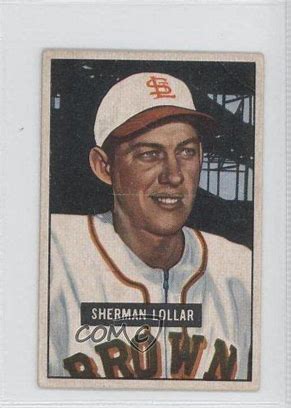Hoffman of The Sporting News continued to expound on Sherman Lollar’s skills under the sub-heading of “Shotgun for an Arm.” I know he was a reporter, but I also feel he was a fan, traveling with the White Sox for eight years. He was with the Chicago
Sun Times for 25-years and is credited with starting the Golden Jubilee Sports Benefit for the Chicago White Sox and Chicago Cubs, according to his October 28, 1964, obituary at 61-years old. At that time, Sherm was the bullpen coach for the World Champion Baltimore Orioles, earning his second ring in 1966 with a pitching staff that included Jim Palmer, Dave McNally, Steve Barber, Wally Bunker, Eddy Watt, and Moe Drabowsky.
Before Lollars 18-year catching career ended in 1963, he spent 12-years with the Chicago White Sox. It was Manager Paul Richards, a catcher once himself, that made the trade from the Browns possible in 1952. Some observers may have noted, “you know that boy just saunters from the dugout to the plate and from the plate to the dugout… looks kind of lazy” Richards retorted, “I’m not concerned with what he does going to and from the plate. It’s what he does at the plate and behind it that counts.”
Hoffman went on to point out that “one of the things Lollar did last season (1954) was to throw out the last 18 runners who tried to steal on him. No one in fact stole on him after May 11 and only four of 22 made it all season.
“And one of the things Lollar did at the plate this season (1955) was to hit seven home runs in ten days from April 23 through May 3.”
“If there are any catchers in the American league as good as or better than Lollar they would have to be Cleveland’s Jim Hogan, and the Yankees’ Yogi Berra. Oddly enough he was unable to become the Indians’ catcher because of Hegan, and he missed taking over the number one job with the Yankees because of Berra. It was only natural then that he should move on to other clubs, but still the way wasn’t easy, because it required some imagination and much practical knowledge of catching to appreciate Lollar’s capabilities.”
Browns Price Was High
“Such a connoisseur was Paul Richards, who, (as previously mentioned) was himself a former catcher and manager of the White Sox from 1951 through ’54,” Hoffman continued.
“Lollar was acquired from the St. Louis Browns, November 26, 1951, in a deal which sent Shortstop Joe DeMaestri, First Baseman Gordon Goldsberry, Outfielder Jim Rivera, Southpaw Dick Littlefield, and Catcher Gus Niarhos to the Browns for Lollar, Pitcher Al Widmar, and Infielder Tom Upton.
“At the time, General Manager Frank Lane said:”
“We went all out to get Loller because Richards wanted him. He’s one of the top three catchers in the American League. Two others. of course, are Yogi Berra and Jim Hegen.”
“Said Manger Richards:”
“We might have won the pennant in 1951 if we had had Lollar. He has a better throwing arm than any other catcher we had. He’s as good of glove man as Gus Niarhos, but more durable. He’ll catch more than 100 games for me.”
“Lollar did catch more than 100 games for Richards in each of the three succeeding years. He caught 352 games in three seasons and will catch more than 100 again in 1955.”
However, Lollar’s first season with the White Sox was his worst, after three big years with the Browns. In 1950, he batted .280, hit 13 homers, and drove in 65 runs. Most importantly, ace Pitcher Ned Garver selected Sherm as his personal catcher and won 20-games in 1951. In November of 1951 came the trade and he was “quite flattered by that, but I started pressing in my anxiety to do well for Richards in 1952 and the result was I had a bad season.” Not one to make excuses, he’s also quoted as saying to a Sports Illustrated reporter in 1960 that, “nineteen fifty-two was a nightmare, the worst year I’ve had in baseball. My wife had become ill after the birth of our first son, and that was on my mind. Then I got off to a bad start when the season opened, and nothing seemed to go right. It went on like that for five and a half months.”
That would soon change…to be continued.

Leave a Reply